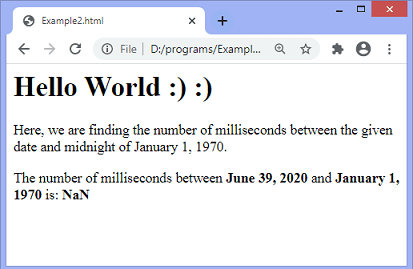JavaScript date parse()方法
JavaScript中的parse()方法用于解析指定的日期字符串,并返回指定日期与1970年1月1日之间的毫秒数。如果字符串没有有效值或无法识别,则该方法返回NaN。
通过计算两个指定日期之间的毫秒数,我们可以通过简单的计算找到小时数、天数、月数等。
语法
date.parse(datestring);
它包含一个表示日期的参数字符串。此方法返回一个表示毫秒数的数字。
让我们来看一些使用 parse() 方法的示例。在第一个示例中,我们传递有效的日期值,而在第二个示例中,我们传递无效的日期值以查看结果。
示例1
在这个示例中,我们传递一个有效的日期,以获取指定日期和 1970年1月1日 午夜之间的毫秒数。
这里,指定的日期是 “2020年6月19日” 。
<html>
<head>
</head>
<body>
<h1> Hello World :) :) </h1>
<p> Here, we are finding the number of milliseconds between the given date and midnight of January 1, 1970. </p>
<script>
var d1 = "June 19, 2020";
var m1 = Date.parse(d1);
document.write("The number of milliseconds between <b> " + d1 + "</b> and <b> January 1, 1970 </b> is: <b> " + m1 + "</b>");
</script>
</body>
</html>
输出

示例2
在这个示例中,我们传递了一个无效的日期,以查看当我们提供无效输入时会发生什么。
<html>
<head>
</head>
<body>
<h1> Hello World :) :) </h1>
<p> Here, we are finding the number of milliseconds between the given date and midnight of January 1, 1970. </p>
<script>
var d1 = "June 39, 2020"; //an invalid date
var m1 = Date.parse(d1);
document.write("The number of milliseconds between <b> " + d1 + "</b> and <b> January 1, 1970 </b> is: <b> " + m1 + "</b>");
</script>
</body>
</html>
输出
在输出中,我们可以看到结果是 NaN .

 极客笔记
极客笔记